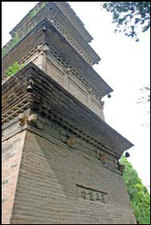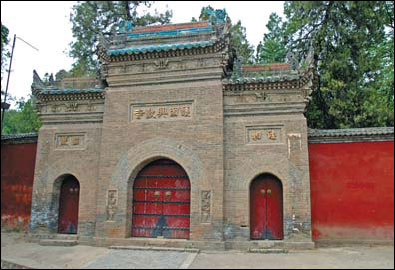Buddhist temple seeks to preserve on-site buildings
Updated: 2013-04-11 07:58
By Jin Haixing (China Daily)
|
||||||||
|
Above: A gate of the Xingjiao Temple in Xi'an, Shaanxi province.Right: The pagoda where the remains of Xuanzang, a prestigious Chinese Buddhist monk and traveler, was buried. Photos Provided to China Daily |

Experts called for more discussions and consultations on protecting a famous Buddhist temple, which was asked by the local government to remove most of its buildings.
Part of the Chinese section of the Silk Road, the Xingjiao Temple was told to remove the buildings as part of local government efforts related to the preparation for the Chinese Silk Road's UNESCO World Heritage Site application, authorities said on Wednesday.
Xingjiao Temple, in Duqu township in Chang'an district of Xi'an, Shaanxi province, is famous because the bone relics of a renowned Chinese Buddhist monk named Xuanzang were buried there.
The Tang Dynasty (AD 618-907) monk became famous for his 17-year overland journey to bring Buddhist scriptures from India to China, which provided the inspiration for the classical novel Journey to the West, written by Wu Cheng'en during the Ming Dynasty (1368-1644).
The temple, with a history of 1,300 years, will apply for the World Heritage List with the pagoda, where the remains of Xuanzang are buried.
The temple received a notice from the local government to remove almost two-thirds of its buildings before the end of May. Wang, the head of the publicity department of Chang'an district in Xi'an, confirmed the news to China Daily on Wednesday.
A team that includes experts from city planning, cultural relics preservation and architecture had conducted detailed field research for the preservation plan of the temple, he said.
The removal will focus mainly on those buildings constructed by the monks themselves, which have little value for cultural preservation, he told China Daily.
However, monks of the temple expressed their concerns about the plans.
The monks said they support the program, but they do not want to remove so many buildings, which will affect their daily religious life because different sections of the temple have their own functions, according to a report in Nanfang Metropolis Daily.
"Actually, the different suggestions from the two sides reflect two conceptions in terms of cultural relic protection," said Pang Shouyong, a professor of Minzu University of China in Beijing.
In order to keep an original image of the temple, mainly the pagoda built during the Tang Dynasty (618-907), it is reasonable that the government wants to move out other buildings, and experts also did many jobs for the planning, he said.
But those other buildings, built in later periods, such as those from the Qing Dynasty (1644-1911) or modern China by monks in the temple, have become important parts of the temple, said Pan, who is an expert in cultural relic preservation.
Without efforts from monks in different periods, the pagoda could not have been preserved, he said.
"The two sides should carefully discuss the project and candidly express ideas for the plan of the preservation," Pan said.
Wang, from the Chang'an district government, said it will arrange for the monks' accommodation during the removal project.
Wang also said the temple area will become larger, and a parking lot will be built in front of the temple.
Previous reports said the construction and planning of a project to build Xingjiao Temple as a tourist destination was conducted by Daming Palace Investment Group, a company in Xi'an.
According to a government statement, the temple area will be divided into four sections for tourism development.
However, the company announced in a statement on its website that the company is not involved in the temple's preservation project.
A male worker from the company who did not want to give his name said on Wednesday the company participated in the early planning, but the project was later transferred to the district government.
Lu Hongyan in Xi'an contributed to this story.
jinhaixing@chinadaily.com.cn
(China Daily 04/11/2013 page7)

 In Photos: 7.0-magnitude quake hits Sichuan
In Photos: 7.0-magnitude quake hits Sichuan
 Li Na on Time cover, makes influential 100 list
Li Na on Time cover, makes influential 100 list
 FBI releases photos of 2 Boston bombings suspects
FBI releases photos of 2 Boston bombings suspects
 World's wackiest hairstyles
World's wackiest hairstyles
 Sandstorms strike Northwest China
Sandstorms strike Northwest China
 Never-seen photos of Madonna on display
Never-seen photos of Madonna on display
 H7N9 outbreak linked to waterfowl migration
H7N9 outbreak linked to waterfowl migration
 Dozens feared dead in Texas plant blast
Dozens feared dead in Texas plant blast
Most Viewed
Editor's Picks

|

|

|

|

|

|
Today's Top News
Live report: 7.0-magnitude quake hits Sichuan, heavy casualties feared
Boston suspect cornered on boat
Cross-talk artist helps to spread the word
'Green' awareness levels drop in Beijing
Palace Museum spruces up
First couple on Time's list of most influential
H7N9 flu transmission studied
Trading channels 'need to broaden'
US Weekly

|

|








